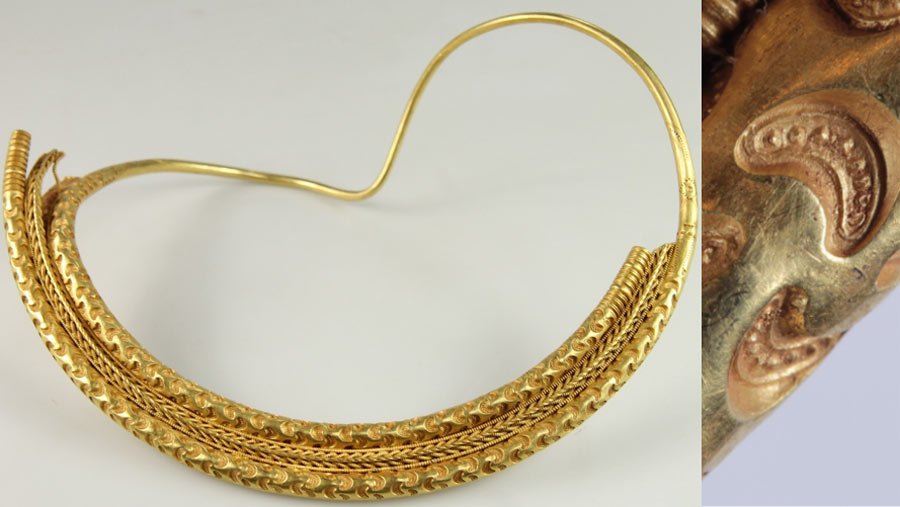Bronze Age swords and sets of bounties Unearthed in Greece
The first period of this year’s excavation in the Trapeza plateau, eight kilometres southwest of Aegio, was completed, bringing to light, among other things, valuable sets of gifts and bronze swords. The place is identified with Rypes, a city that flourished in early historical times and participated in colonization, founding Croton in great Greece.

The excavation focused on the research of the Mycenaean necropolis, which develops on the southwestern slope of the plateau and is located on the ancient road that led to the citadel of historical times.
The tombs are chambered, carved into the soft sandy subsoil. Their use was long-lasting and intensive, already during the first palace period of the Mycenaean world, in parallel with the prosperity of the great centres of Mycenae, Tiryns and Pylos.
Significant reuse of the tombs dates back to the 12th century BC, when the tombs were reopened and repeatedly while being a place of burial customs and complex ritual practices until the end of the Bronze Age, during the 11th century BC.
The excavation at the necropolis yielded valuable sets of gifts consisting of vases, a number of seal stones and all kinds of beads and voices from various materials – glᴀss, faience, gold, corneol, mountain crystal – composing necklaces and ornate jewellery in the shape of jewels, in trade relations with the eastern Aegean and Cyprus.
The chamber of tomb 8, in the shape of a rectangle, which was investigated this year, presented a complex stratigraphy. In the first layer of tombs of the 12th c. BC, three burials were investigated by country, decorated with pseudo-mouthed amphorae.
The bones of the older tombs had been removed and placed with respect and great care in two superimposed piles at the back of the chamber in contact with the walls of the tomb. At the top of these excavations, three written clay alabasters and an amphora date these first burials to the early palace period (14th century BC).
Among the bones and offerings that accompanied these ancient burials, glᴀss beads and cornaline, a clay horse figurine, was placed an exceptionally preserved bronze sword.

At the base of the pile of bones, two more intact bronze swords were also found, which also save part of their wooden handles. The three swords belong to different types, Sandars D and E, and date back to the heyday of the Mycenaean palace period.
The presence of these weapons, as well as the long spears of the same chronological period found during the excavation in neighbouring tombs in the necropolis of the Bank, is particularly important. It is distinguished from the other necropolises of Achaia by emphasizing the direct dependence of the local community on the powerful palace centres.
The weapons are products of the palace workshops, perhaps of Mycenae, thus in line with the Epic and the mythological tradition handed down to us.
According to it, Achaia belonged to the kingdom of Agamemnon and the conqueror of Mycenae gathered in neighbouring Aigio the most valuable men in order to discuss how the campaign against the Priam state should be carried out.
The location of the Mycenaean settlement of Trapeza is still not clear enough.
Probably, during the early cycle of use of the necropolis, the settlement was located on a hill, about 100 meters south of the Bank.
This year, in parallel with the research in the Mycenaean necropolis, the excavation of part of the settlement, revealed part of a building, perhaps a mansion. It is a wide rectangular room with a hearth in the centre and typical pottery that dates back to the 17th century. e.g.
READ ALSO: ARCHAEOLOGISTS DISCOVER “UNIQUE” CEREMONIAL BRONZE AGE SWORD IN DENMARK
The systematic excavation at Trapeza Aigio, ancient Pollutants, is led by Dr. Andreas G. Vordos, archaeologist of the Ephorate of Antiquities of Achaia.
Elisabetta Borgna, Professor of Aegean Archeology at the University of Udine, participates in the interdisciplinary research program of the Mycenaean necropolis and the prehistoric settlement with a group of students from the Universities of Udine, Trieste and Venice, as well as postgraduate students.
The main sponsor of the excavation at the Bank of Egialia, ancient Pollutants, is the AG Foundation. Leventis. The excavation work is also supported by Olympia Odos SA.





